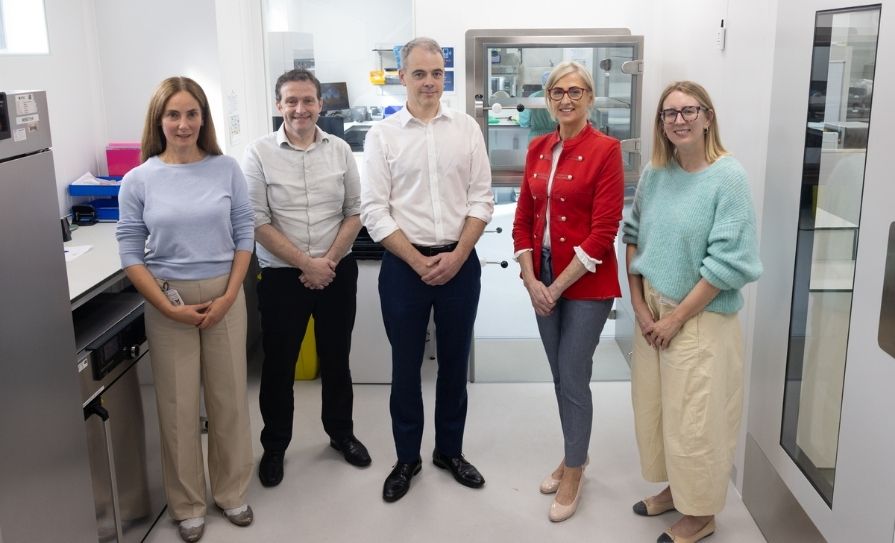Service homes in on improving patient quality of care and outcomes by bringing X-ray services directly to older people in the community
Due to the success of a pilot project, the HSE is expanding a free, national rapid response community-based X-ray service older patients in nursing homes, community facilities, and in patients’ homes. This means patients can have X-rays taken in the nursing home or facility where they reside instead of having to go to the hospital.
The service is currently running in Dublin, Wicklow, Meath, Kildare, Louth, Cork, Limerick, Clare, and North Tipperary and since August is offered in South Tipperary, Carlow, Kilkenny, Waterford, and Wexford. It will be available nationwide in 2024 with Galway and the northwest next in line to benefit from the service.
What this mobile X-ray service provides
- All types of X-ray examinations including chest, hip/pelvis, knee, wrist, and shoulder;
- If an older patient has a fall, or requires a chest X-ray, the diagnostic team will arrive on-site;
- An X-ray examination will take place in their own room and a report is shared with the referring doctor within four hours;
- Some 83 per cent of nursing homes in Dublin, Cork, and Limerick have used the service;
- Referrals to the service are triaged in conjunction with the nursing home and GP to ensure timely diagnosis and treatment.
Rita Hesnan is a resident of a nursing home in Co Wicklow. Recently, her GP requested an X-ray to support their diagnosis after she became unwell, resulting in the mobile X-ray service being called out.
Her niece Yvonne Morris, explained: “My aunt is prone to chest infections and gets them quite a lot. Recently, her GP recommended she have an X-ray but to bring her to an emergency department would be confusing for her. To help her GP with their diagnosis, this mobile X-ray service came to her room in the nursing home where she resides. The X-ray was done in the place where she felt happy and safe and we had the results back in a few hours. It is a great service and was a stress-free experience for my aunt, which was the most important factor.”
The X-ray was done in the place where she felt happy and safe and we had the results back in a few hours
Welcoming the initiative, Minister for Health Stephen Donnelly said: ‘‘The HSE is now moving from a successful innovative pilot project to rolling this mobile X-ray service out nationally on a phased basis. I welcome this development. The new service means that if an older patient in a nursing home has a fall, or requires an X-ray such as a chest X-ray, then the diagnostic team will arrive on-site and an X-ray examination will take place in their own room in the nursing home, and a report is shared with the referring doctor within four hours.
“This mobile X-ray service is delivering clear benefits to older patients and is avoiding unnecessary attendance for many frailer people at emergency departments. This is a very good example of how new ways of working can enable us to better respond to the health needs of our older patients. Promoting care in the community for older people and improving access to services is a priority for me and this government. There are real benefits in bringing this service to older patients who, if they are frailer, may not be able to travel easily to a hospital.’’
Minister for Mental Health and Older People Mary Butler added: “I warmly welcome the phased roll-out nationally of this new community-based mobile X-ray service by the HSE. The pilot programme was very successful, meaning older, frailer patients, and those with complex care needs benefited greatly in avoiding a journey to a busy acute hospital. This national roll-out will be a really important resource especially for those with dementia as travelling to unfamiliar facilities can be very upsetting, while impacting on normal routine.
“Providing the correct wrap around supports in the community are essential to allow our older population to age well at home. This initiative will also be of great benefit to those living in nursing homes and community facilities on the occasion they may need access to an X-ray as determined by their GP.”
Damien McCallion, HSE Chief Operating Officer, said: “This new service in the community is a very effective example of patient-centred care, and how capacity in hospitals can be freed up. It is part of our 2023 Urgent and Emergency Care Plan. The availability of this very successful mobile X-ray service means that if an older patient in a nursing home has a fall where this service is available then an X-ray can be requested by the GP to rule out a fracture without the patient having to travel to the hospital.
“There’s a real benefit in bringing this service to older patients who are often frail, may be immobile, and not able to travel easily to a hospital. For dementia patients, in particular, preventing a transfer to the hospital for an X-ray is very beneficial. GPs refer patients to the service which is designed to provide fast, high quality images that can aid doctors to make accurate diagnoses as early as possible. It’s a prime example of the sort of innovation that will help us to meet the challenges of the future.’’
Supporting the rollout, Dr Eimear Ahern, HSE National Clinical Lead for Older Persons, said: “This is a positive community intervention for older adults with complex needs and frailty who now avoid an attendance and prolonged wait on a trolley in the ED when only an X-ray is required by the person’s GP to support the diagnosis.
“We have seen a reduction in the number of transfers to hospital for older adults who are now able to get an X-ray closer to home when needed after a fall. This responsive and safe pathway is a better experience for older adults, and for the people looking after them, and an example of how important and necessary health services can be delivered safely in people’s communities and closer to home. ’’
Joe Ryan, National Director of the HSE Operational Performance and Integration division, said: “This initiative, planned and delivered by the HSE’s Operational Performance and Integration team in collaboration with our Older Adults Services teams, embodies the core Sláinte Care principle of delivering person-centred integrated care as close to home as possible.
“The Operational Performance and Integration Division is constantly working with services to improve patient and service user experience and deliver improved quality and efficiency. This very successful pilot delivered clear benefits to older patients and is avoiding unnecessary attendance for many frailer people at emergency departments. As we move from this innovative pilot project to rolling this out nationally on a phased basis we will build on this success in improving the patient’s experience.”







